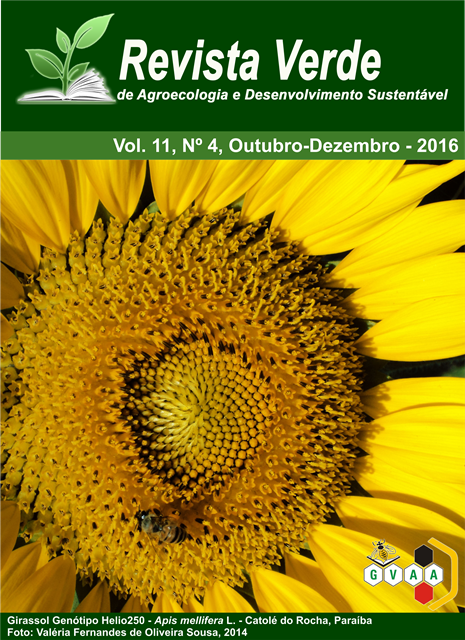Crescimento e absorção de macronutrientes na cultura da melancia no estado de Pernambuco
DOI:
https://doi.org/10.18378/rvads.v11i4.4540Keywords:
Citrullus lanatus Thunb., cultivar Shadow, cultivar QuetzaleAbstract
Objetivou-se avaliar o crescimento e acúmulo de macronutrientes por cultivares de melancia no estado de Pernambuco. O trabalho foi conduzido na estação experimental Bebedouro (Petrolina-PE) pertencente à EMBRAPA Semiárido, no período de setembro a dezembro de 2009. O solo da área experimental foi classificado como argilosolo vermelho-amarelo eutrófico (EMBRAPA, 1999). O delineamento utilizado foi em blocos casualizados completos, com quatro repetições em esquema fatorial 2x5. Os tratamentos resultaram da combinação de duas cultivares de melancia (Quetzale e Shadow) e cinco épocas de coletas: 15, 25, 35, 45 e 55 dias após o transplantio. Em cada coleta foram utilizadas três plantas por repetição. A unidade experimental para o experimento foi constituída por três fileiras de plantas de 10,5 m de comprimento, com espaçamento de 2,0 x0,50m perfazendo um total de 63,0 m2. As coletas de plantas foram realizadas na fileira central. As cultivares Quetzale e Shadow apresentaram crescimento inicial lento, intensificando a partir dos 25 dias após o transplantio. Maiores incrementos na matéria seca total da parte aérea e do fruto ocorreram no período de 45 a 55 dias após o transplantio. Na colheita, a parte aérea e o fruto da cultivar Quetzale apresentaram os maiores acúmulos de 52%. E os macronutrientes foram absorvidos pelas cultivares na seguinte ordem: K ˃N˃Ca˃P˃Mg.
Growth and macronutrient absorption in the watermelon crop in the State of PernambucoAbstract: This study aimed to evaluate the growth and accumulation of macronutrients by watermelon cultivars in the state of Pernambuco. The experiment was conducted in the experimental station of Bebedouro (Petrolina-PE) which belongs to EMBRAPA Semiarid from September to December in 2009. The soil of experimental area was classified as red-yellow eutrophic claylish soil.The experimente was done in a complete randomized with four replications in a factorial scheme 2 x 5. The treatments resulted from the combination os two cultivars of watermelon (Quetzale and Shadow) and five collects: 15, 25, 35, 45 and 55 days after transplanting. Three plants were used per repetition in each collect. The experimental unit consisted of three rows of plants with 10,5 m long, spaced by 2,0 x 0,50 m making up 63,0 m2. The plants were collected from the central row. The cultivars Quetzale and Shadow presented slow initial growth, improving from the twenty-fifth day after transplanting. The largest increases in the total dry matter of the aerial part and fruit happened between 45 and 55 days after transplanting. At harvest, the aerial part and the fruit of the cultivar Quetzale presented the largest accumulations , in a total of 52%. And the macronutrients were absorbed by both cultivars in the following order: K ˃ N ˃ Ca˃P ˃ Mg.











